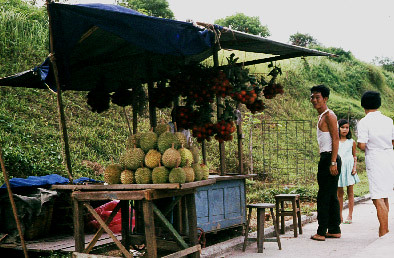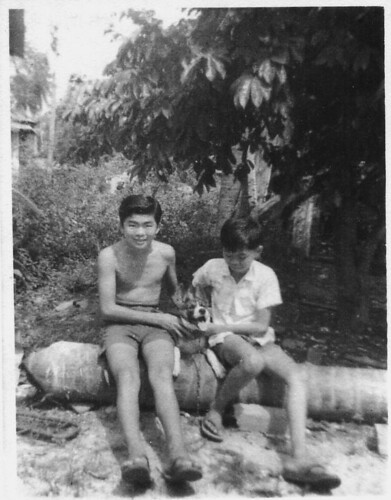
A 1960's Photo of a roadside durian stall along Farrer Road, courtesy of Memories of Singapore
In our kampong, we used to have lots of fruit trees. Tree climbing was one of our favourite pastimes. Do you know which tree is best for climbing? The guava tree - because of it’s strong branches. We called the guava fruit ‘pak kia’ in Hokkien and ‘kai see kor’, (literally, chicken shit fruit) in Cantonese. We had 2 types of fruits; one with white and the other with pink flesh. The seeds of the guava fruit are extremely hard and indigestible. The result of eating them was that we tended to, as they put it so nicely in the army, ‘shit bricks’.

My naughty niece with a piece of toy shit
My favourite fruit from the kampong days was the soursop. Our tree was very fruitful and produced huge fruits which were much bigger and tastier that those you can buy in the market today. Soursops are quite costly these days, and many fruit vendors do not like to stock them because they ripened very quickly, and cannot be stored for long. Talking of the soursop tree always reminds me of the fat, green caterpillars that tended to breed on it. I think they are from some kind of moth.

Me (left, aged about 14 or 15) and my brother James and our dog Nappie sitting of a coconut tree trunk. Behind us is our soursop tree.
We too had a durian tree which I have already blogged about here.
Of course we also had a few rambutan trees. I remember my mum brought three saplings all the way back by train from a visit to her relatives in Kuala Lumpur on one occasion. Apparently these were special and did not grow to be very large. I had a godmother in the kampong. In her house, they had a tree which produced yellow colour rambutans. Besides that they also had star fruits.
Another fascinating tree was the coconut tree which I have also blogged about here. I recall climbing up a young coconut tree once. The young tree tended to be curved and quite easy to climb up. But climbing down was a totally different ball game; and I remember having a scary time doing that.
The coconut tree is also interesting because it had a huge root base. There was one occasion when we got people to chop down a full-grown coconut tree. To save money, we decided to dig up the tree stump ourselves. I remember what a tough job that was. All the 4 males in the family, except for my kid brother James, were involved, and I think it took us a whole day to complete the job. In the process, we saw many centipedes. Maybe that’s why the Hokkiens called the centipede ‘yar kang’. (yar as in coconut, kang – I don’t know what that means)
The husk of the coconut makes a very good fuel and can burn for a long time. My father taught me how to use it to produce burnt earth for our gardening purposes.
Apart from the above fruit trees, we also had pomeloes – small ones unlike those from Ipoh, Tambun. They had long, sharp, needle-like thorns. We also had water apples (in Cantonese we call sui yong) and of course, papayas.
…….. to be continued





11 comments:
Chun See, you should have trained a monkey to pluck coconuts for you. I saw this still being practised in Malaysia some years back. It is safe, efficient and best of all, you only need to pay it peanuts, literally. (How's that as a management tip to a management consultant? :p)
Some terminology here: "water apple" is also known as "jambu air mawar", "jambu air" or simply "jambu" in Malay. More details about this fruit is available here.
Centipede is known as wu2 gong (蜈蚣) in Chinese. So the "gong" is just a sound, doesn't mean "grandfather" or anything, I guess.
My friend chuck will tell you more in a later episode about the Jambu.
Victor, Chun See said he climbed coconut trees. But what gave you the idea that he was aiming for the coconuts? Some kids just like to climb for no reasons one. We know Monkeys are useful animals lah. Other than climbing trees, they are also ideal animals to be used in the lab lor ... ROTFL.
But some city monkeys don't know how to climb trees one - only know how to score with girls.
Buah Susu, Buah Sontok, Buah Limbeh,Buah Longlong,Hor Pow Kor (Nam Nam) Jambu Bol, Mata Kuching, mangosteen,etc... all these fruit trees were located in the protected area off Bukit Gombak Camp 30 years ago.... My friend stayed there and we had a great time plucking those fruits. I wonder if those trees are still there after more than 30 years... I can still recall where those trees are located. Like in Chun See's earlier block where he visited Safti, I wonder if the camp commander allows us to look, take some pictures of those trees and tell Singaporean that we too have a good varities of fruits locally.
I think this is a great blog. It's like a time machine that brings us back to the 50s and 60s. Thanks for helping us, the younger generations see all these wonderful things that has happened in Singapore before our time :)
Thank you. Glad that you liked my stories. Hard to believe that so much change can take place in just one generation.
I hope you won't mind me linking to this post? Your post reminded me why I never get to eat soursop often. I remembered that there was once when my grandmother bought soursop for the family to eat, but we found white creatures in eating....after having sampled a few pieces of soursop...
Oceanskies. Pls go ahead and link. Did you know that the Hokkien name for soursop is Ang Mor Liew Lian? The leaves have a nice smell.
My grand-mother told me that she had a very tall durian tree which bore excellent fruits, resulting in thiefs coming at night to steal our durians (fallen ones). One of my uncles had to guard this tree each night watching out against intruders. According to her, while the tree was growing, much starch and sugar were poured into its root so as to nourish it. As a result of this pain-staking effort, the tree produced mouth-watering durians which brought her good seasonal income.
Post a Comment